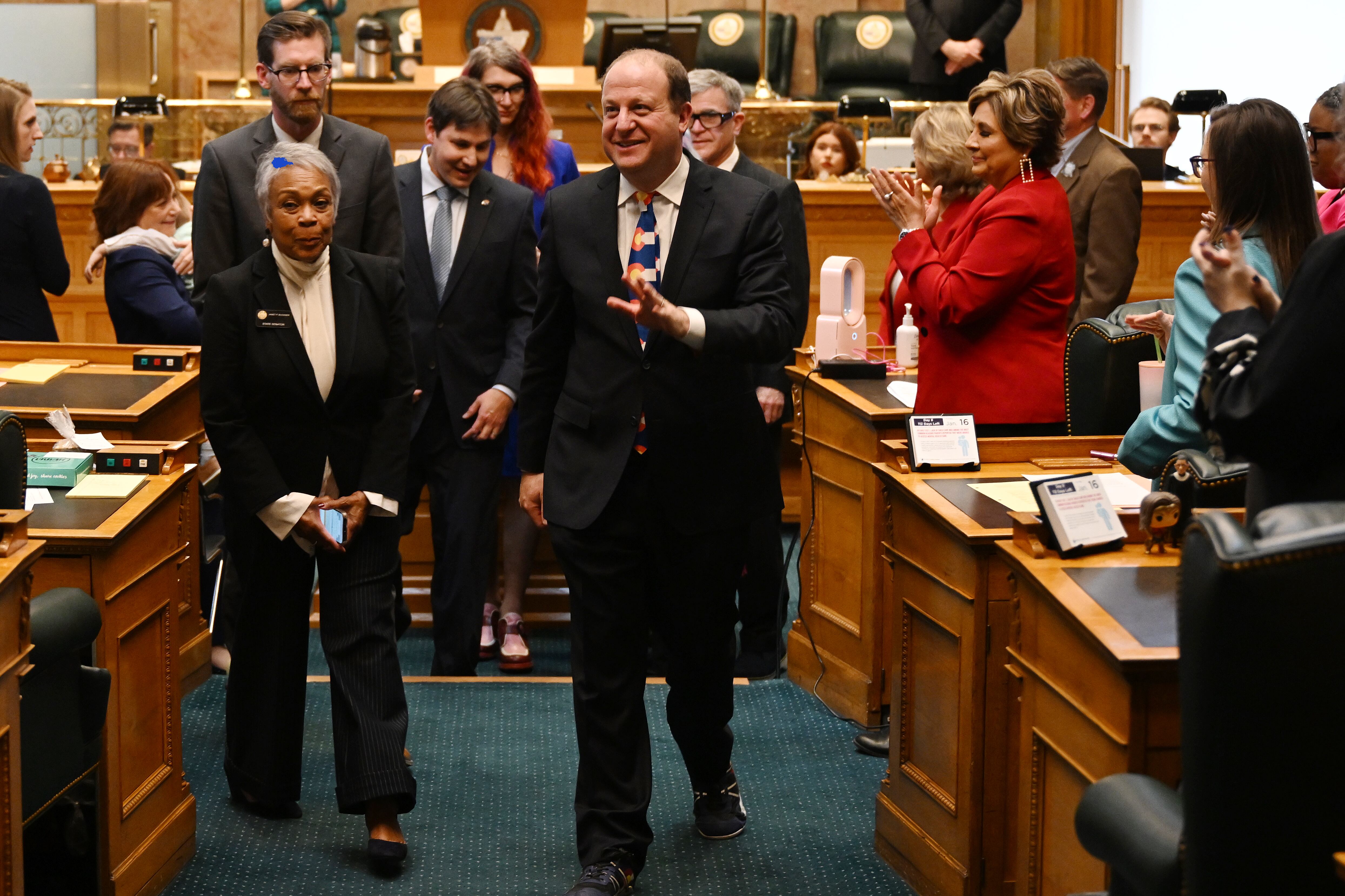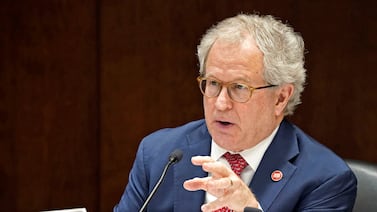In Tuesday’s State of the State speech, Gov. Jared Polis promised to fully fund K-12 schools within four years — something Colorado hasn’t done since the Great Recession — even as he also promised major property tax relief and further reductions in the state income tax rate.
Polis also touted the launch of universal preschool this coming August, asked lawmakers to ask voters to keep more money from nicotine sales to expand preschool, pledged support to help high school students earn college credit, and highlighted efforts to boost students’ math skills.
The speech was Polis’ first State of the State of his second term as governor. Colorado will celebrate 150 years as a state in 2026, the last full year of his second term.
In a speech that leaned heavier on housing and health care than on education, Polis framed his goals as creating more opportunity for all by the time the state marks that milestone.
“At 150, I want to see an education system that prepares every child and learners of all ages for success,” Polis said.
In an interview, Polis said he would only support tax cuts that wouldn’t reduce overall state revenue and that his proposals depend on an ongoing strong economy.
“If we’re going to fund our schools and cut taxes at the same time, the overall economy needs to do well,” he said.
Polis included many of the education policies described in the speech in his recent budget requests, including new training opportunities to help workers get in-demand jobs and more money for afterschool tutoring.
Here are a few education highlights from the State of the State speech.
Polis promises to fully fund K-12 schools
What he said: “I am proud to submit a proposal to buy down the budget stabilization factor to its lowest level ever and set our state on a path to finally eliminate it altogether during my second term, fulfilling our state’s commitment to our schools.”
What it means: Colorado’s constitution requires school funding to go up every year by the rate of population growth and inflation, but every year, lawmakers withhold hundreds of millions that should go to schools to help fund other priorities. The practice known as the budget stabilization factor started in 2009-10 and added up to more than $10 billion.
Eliminating the budget stabilization factor is a longtime priority for the state’s education advocates. Lawmakers have reduced the annual withholding but never eliminated it. Last year they held back $321 million out of more than $5 billion in state K-12 funding.
In a budget letter sent Tuesday, Polis proposed a $201 million withholding and saving money to allow for more so-called buy-downs in future years.
In an interview, Polis acknowledged doing so depends on a continuing strong economy. Republicans believe schools could be funded at a higher level if Democrats scaled back other programs.
Colorado schools would get more money per student
What Polis said: “For K-12 learners, I’m proposing in my supplemental and budget amendment package today that we raise per pupil funding by an additional $925 — or an additional $20,000 for [individual] Colorado classrooms every year … Districts can use these funds to increase pay, like the Lake County School District that raised teacher pay by 16% in just one year with a major bump for staff … Or how Colorado’s two largest school districts are starting their teachers at just over $50,000 per year. That would have been unheard of a decade ago.
“These new funds can also support smaller class sizes, revive extracurriculars, or fund mental health support for our students.”
What it means: The governor said in November he wants $861 more per student. Now he’s calling for an additional $64. That money would bring per-pupil allocations to $10,485.
Many Colorado school districts are losing enrollment, so the bottom line would vary from district to district. The legislature could also send more — or less — money to schools than called for in Polis’ budget request.
In the budget letter, Polis said higher per-pupil funding is possible in part because Colorado has 1,600 fewer students this year than expected and is likely to have 2,700 fewer next school year.
School districts can spend the money how they choose, and many Colorado school districts have raised pay. At the same time, inflation has eaten into the value of those raises. A recent study found the price of housing — another priority for Polis and lawmakers — has risen far faster than educator wages.
Property tax relief is a top priority
What Polis said: “We must work together to pass a long-term property tax relief package that reduces residential and commercial property taxes and creates a long-term mechanism to protect homeowners from being priced out of their homes, while protecting school funding.”
What it means: Property taxes, school funding, and the state budget are closely related. Colorado sets per-pupil funding at the state level and backfills whatever local property tax revenues don’t cover. Higher local property taxes means K-12 school funding can go up without putting as much pressure on the state budget.
Last year’s $700 million property tax relief deal was one reason lawmakers held back from fully funding schools then. The deal meant the state needed to backfill more dollars for districts.
Senate President Stephen Fenberg, a Boulder Democrat, said he doesn’t expect a cut to property tax rates to conflict with the governor’s call to increase school funding. Property values have soared and it leaves room for the state to make cuts while still bringing in enough for K-12.
Speaker of the House Julie McCluskie, a Dillon Democrat, said lawmakers need to find ways to both fund education and provide property tax relief.
“We rank in the bottom of the United States, depending on how you slice that metric, as far as funding, and yes, we have to provide property tax relief,” she said. “We have to be talking about both and what that path is forward.”
Free preschool program could serve more children
What he said: “Free preschool will save families at least $6,000 per year and give our children the best possible start in life. This is a monumental achievement and today is the first day families can apply to enroll their children. I’m so excited to share that more than 4,300 Colorado families have already started applying …
“I’m calling for the legislature to refer a ballot measure that would allow Colorado to utilize excess Prop EE funds for preschool, just as the legislature did on a bipartisan basis for excess marijuana funds in 2015. This would give voters the choice to support more services for more children and help lower-income families enroll their child in full-day preschool.”
What it means: The parent application for Colorado’s new free preschool program opened just hours before Polis’ speech.
The program uses money from Proposition EE, a voter-approved nicotine tax, to pay for at least 10 to 15 hours a week of tuition-free preschool for all 4-year-olds statewide, with many students eligible for 30 hours of free preschool. Some 3-year-olds will be eligible for 10 hours as well.
But excess tax collection must be sent back to taxpayers. A ballot measure would ask voters to ensure all of the money the state collects, even above the limit of the 2020 ballot measure, would go to preschool. That could allow the state to pay for more hours and open seats to more 3-year-olds.
Student math skills suffered during pandemic learning
What he said: “The last few years have been tough for our K-12 learners and educators, and those challenges are reflected in test scores, particularly math. To help improve achievement, we are proposing new investments in high-quality math curricula and training to ensure that our educators have the support they need to help all our students thrive. And we are increasing our commitment to high-quality before- and after-school programming.”
What it means: Student math scores declined since before the pandemic, showing bigger decreases than reading. The governor has proposed a one-time $25 million for after-school math tutoring and $3 million for new curriculum. Legislators have also proposed improving teacher training and educating parents on how to help kids with math.
The state has made a long-term effort to boost reading skills, but no such effort exists for math. And so far, no one has proposed that kind of systemic reform or tracking of student skill in math.
Polis proposes more training for workers, free college credit
What Polis said: “The reality is that today’s economy demands access to quick skill acquisition, whether that is a one-, two- or four-year degree, professional training, an apprenticeship, or on-the-job training. We are going to jump-start access to training to help more Coloradans be career ready, earn more, and power our economy.”
What it means: Colorado has a worker shortage. For every two jobs available, there’s only one qualified worker. Colorado also has many adults who could benefit from workforce training and fill those in-demand jobs.
The governor would spend about $70 million to provide free career training in in-demand fields and scholarships to students. The money would help about 35,000 recent graduates and older adults get training in the most in-demand fields like advanced manufacturing, education, law enforcement, and nursing fields.
Jason Gonzales is a reporter covering higher education and the Colorado legislature. Chalkbeat Colorado partners with Open Campus on higher education coverage. Contact Jason at jgonzales@chalkbeat.org.
Bureau Chief Erica Meltzer covers education policy and politics and oversees Chalkbeat Colorado’s education coverage. Contact Erica at emeltzer@chalkbeat.org.





